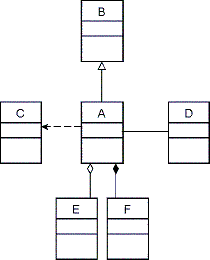Know

- UML class diagrams with a single class
- Class diagrams consisting of individual classes connected by class relationships
- The meaning of each UML class relationship
- The roles each class plays in a class relationship
- The general (non-computer science) meaning of hierarchy
- The meaning of inheritance, composition, and aggregation hierarchies
- Peer-to-peer relationships with one-to-one association (know about many-to-one and many-to-many associations)
- The meaning and use of a forward declaration
- How to implement the class relationships in C++ (similar to recognizing them - see below)
- How to use header files while implementing class relationships
- #ifndef/#endif
- #pragma once
- class class-name; //a forward declaration: only works with pointers
- How to recognize a class relationship by its UML symbol (at right)
- How to recognize a class relationship by its C++ code pattern
Inheritance Composition Aggregation Dependency class Foo { ... };class Bar : public Foo { ... };class Bar { private: Foo f; };class Bar { private: Foo* f; };class Bar { public: void function(Foo f) {...} };Association class Foo; // forward declaration (pointer only) class Bar { private: Foo* f; };class Bar; // forward declaration (pointer only) class Foo { private: Bar* b; }; - How to chain constructor calls when implementing class relationships
- How to chain member function calls when implementing class relationships